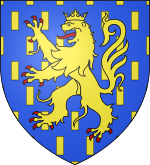Besançon courthouse attack
1970 crimes in FranceBuilding bombings in FranceExplosions in 1970Far-right politics in FranceGaullism ... and 6 more
History of BesançonImprovised explosive device bombings in FranceMay 1970 events in EuropeOrganisation armée secrèteRight-wing terrorist incidentsTerrorist incidents in France in 1970

A terrorist attack targeted the Besançon courthouse on 9 May 1970. It was perpetrated with a bomb by two men from OAS and UDR movements, in a context of resurgence of far-right violence in France.
Excerpt from the Wikipedia article Besançon courthouse attack (License: CC BY-SA 3.0, Authors, Images).Besançon courthouse attack
Rue Mégevand, Besançon Chamars
Geographical coordinates (GPS) Address Nearby Places Show on map
Geographical coordinates (GPS)
| Latitude | Longitude |
|---|---|
| N 47.2374843 ° | E 6.0236485 ° |
Address
Palais de Justice
Rue Mégevand
25000 Besançon, Chamars
Bourgogne-Franche-Comté, France
Open on Google Maps









